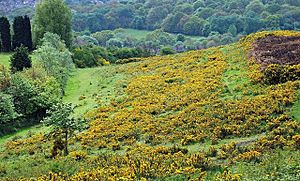Pensnett Chase facts for kids
Pensnett Chase was a large area of woodland near Dudley Castle. It belonged to the Lords of Dudley. This land was mainly in the areas of Kingswinford and Dudley.
A "chase" was a special type of land. It was used by the lords for hunting wild animals. But local people could also use it as "common land." This meant they could graze their animals or collect wood there. Over time, much of the old forest was cut down.
Later, the part of the Chase near Dudley became known as Dudley Wood. The name Pensnett Chase mostly referred to the part in Kingswinford. In the 1700s, this was a huge area of common land. It was later divided up into private plots. This process is called enclosure. The mines under the land were kept by the lord of the manor. Pensnett Chase stretched from the area now called Pensnett through Brierley Hill to Quarry Bank.
History of Pensnett Chase
Pensnett Chase was a wooded area located south and west of Dudley. It became the property of Ralph de Somery in the early 1200s. He was one of the important barons of Dudley Castle. This land was once part of the Forest of Kinver. King John traded it for other land in Wolverhampton.
What Was a Chase?
The word "Chase" means the woods were used for hunting. But they were also "common lands." This meant local people had rights to use them. They could let their animals graze there. They could also gather wood for fires. The name 'Pensnett' likely comes from two old words. 'Pen' means a hill, and 'snaed' is an Old English word for a wood.
The original Chase was bordered by the River Stour to the south. This river separated the common land from the manor of Cradley. The western border is not as clear. A map from the 1600s shows the Chase reaching further than Enville. Over many years, the Chase lands became smaller. Parts were fenced off and became private property.
Deer Parks and Mining
Around the 1230s, Roger de Somery, a relative of Ralph, fenced off part of the Chase. He created a "New Park" there. This was done to raise deer for hunting. This area of England is known as the Black Country. It was rich in natural resources. These included coal, iron ore, and different types of clay.
People had been mining coal in the Chase since at least the 1200s. This mining brought money to the Lords of Dudley. They continued to use the Chase for hunting as well.
Industry and Enclosure
Making iron and forging metal started in the area during the Tudor period. Digging up minerals from underground became a huge source of wealth. This was especially true for the Sutton and Ward families. They took over from the de Somerys. By the 1600s, most of the old forests were gone. However, new trees were planted. These new trees provided wood to make charcoal. Charcoal was very important for the local iron industry.
The Stourbridge Canal was built across the Chase in 1776. This made the area even more appealing for industrial use. The common lands were formally enclosed in 1784. This meant the land was divided and sold to private owners. The Lords of Dudley also received parts of the land.
This enclosure officially ended Pensnett Chase as common land. However, the name was still used for the area well into the 1800s. For example, a newspaper in 1850 mentioned: "St Mark's, Pensnett, a beautiful church built in a wood called Pensnett Chase near to Dudley..."


